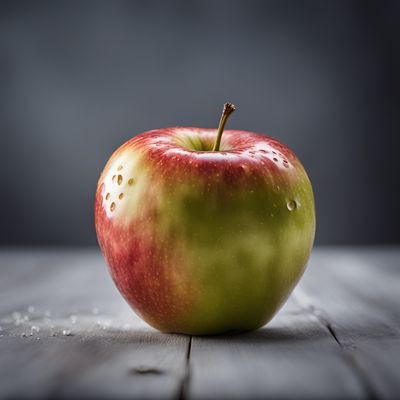
Ingredient
Apples and similar-
The Versatile Fruit: Apples and Their Kin
Apples and similar fruits, such as pears and quinces, are characterized by their crisp texture, refreshing juiciness, and varying levels of sweetness. They come in a variety of colors, from vibrant reds to golden yellows and deep greens, and can range from tart to sweet in taste. These fruits are often used in pies, tarts, salads, sauces, and even savory dishes like pork roasts or stews.
Origins and history
Apples have a rich history dating back thousands of years, with origins believed to be in Central Asia. They have been cultivated and enjoyed by various civilizations, including the ancient Greeks and Romans. Apples hold cultural significance in many countries, often symbolizing love, temptation, or knowledge. They were brought to North America by European settlers and have since become a staple in American cuisine.
Nutritional information
Apples and similar fruits are low in calories and fat, while being a good source of dietary fiber and vitamin C. They also contain antioxidants that contribute to overall health and well-being.
Allergens
Apples and similar fruits are generally safe for consumption, but some individuals may have allergies or sensitivities to certain varieties. Allergic reactions are rare but can occur, particularly in individuals with birch pollen allergies who may experience oral allergy syndrome when consuming raw apples.
How to select
When selecting apples and similar fruits, look for firm, unblemished skin with vibrant colors. Avoid fruits with bruises, soft spots, or wrinkled skin. The fragrance should be pleasant and slightly sweet. Different varieties have different levels of sweetness and tartness, so choose according to your preference or recipe requirements.
Storage recommendations
To maintain freshness, store apples and similar fruits in the refrigerator, preferably in a perforated plastic bag to retain moisture. They can also be stored in a cool, dark place, such as a cellar or pantry, for short periods. Avoid storing them near other fruits or vegetables that release ethylene gas, as this can accelerate ripening and spoilage.
How to produce
Apples and similar fruits can be grown in home gardens or orchards, provided the appropriate climate and growing conditions are met. They require well-drained soil, full sun exposure, and regular watering. Pruning and pest control measures may also be necessary to ensure healthy growth and fruit production.
Preparation tips
Apples and similar fruits can be enjoyed in various ways, such as raw as a healthy snack, sliced in salads for added crunch and sweetness, or cooked in pies, tarts, and compotes. They can also be juiced, dried, or used to make applesauce or cider. When using apples in cooking, consider the variety and its level of sweetness or tartness to balance flavors in the dish.
Substitutions
Pears and quinces can be used as substitutes for apples in most recipes, offering similar textures and flavors. However, keep in mind that the taste may vary slightly, so adjust seasonings or sweeteners accordingly.
Culinary uses
Apples and similar fruits are widely used in both sweet and savory dishes. They are commonly found in pies, tarts, cakes, muffins, and other baked goods. They can also be used in salads, sauces, chutneys, and jams. In savory dishes, apples pair well with pork, poultry, and game meats, adding a touch of sweetness and acidity to balance flavors.
Availability
Apples and similar fruits are cultivated in many regions around the world, including North America, Europe, Asia, and Australia. Specific varieties may be more prevalent in certain countries, such as the Granny Smith apple in Australia or the Honeycrisp apple in the United States.

